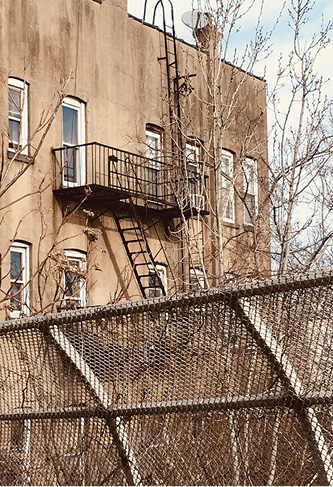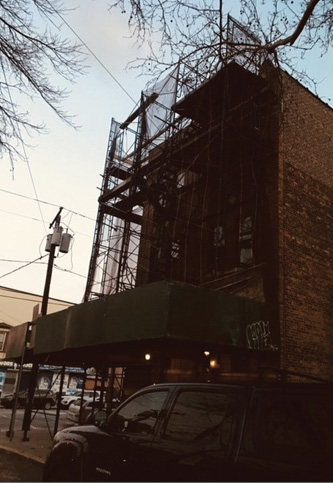TRAINING NOTEBOOK ❘ By ALEXANDER DEGNAN
A unique, but not altogether uncommon, circumstance is encountering a top-floor fire where conditions on arrival make getting to the roof exceedingly difficult. Of course, I am referring to wires or obstructions at street level precluding raising the aerial and a roof height beyond the reach of ground ladders. Ladder companies should carry ground ladders of sufficient length to reach the roofs of most occupied multiple dwellings (excluding residential high-rises) in their district. However, off-duty companies, spare apparatus, ground ladders out for service, and unpassable alleys are just some examples of the myriad of circumstances that can hamper firefighters‘ ability to make that roof.
- Tom Brennan: THIS TIME, GET THE ROOF!
- Matthew Murtaugh: GET THE ROOF
- Making the Most of Roof Operations
This article will discuss some of the simple actions we can take under duress to ensure we get to the roof. Addressing the plethora of issues with fire escapes themselves is not the concern here, only when the fire escape is the only way up and the situation is not looking good. Bear in mind, the decision to get to the roof may be out of our hands under said circumstances. A commanding chief may see no way to secure adequate additional egress and elect not to send teams to the roof. This decision is beyond the scope of this article and one of the toughest to make. However, as we will see, by making every effort to provide that topside relief, we sometimes make a quick tradeoff and secure additional egress in the process.
The Scenario
You are part of a two-member roof team charged with getting to the roof a six-story, Class 3, unattached apartment building. The fire is in the rear of the top floor and has an obvious head start on arriving crews. As stated above, for any number of reasons, your quickest and most direct option is the fire escape. Without one visible street side, you and your partner report to the rear yard and see heavy smoke chugging out the rear top-floor windows. How do you proceed, knowing that aerials are not getting up and ground ladders are short?
Before addressing the answer to that question, let’s assume that you are going to get to the roof, give the roof report, take the naturals, vent offensively over the fire so the attack team can achieve success, and monitor cockloft extension. What are the best ways to safely protect yourself and aggressively get to the roof by a fire escape that is currently being threatened?

(1) A drop-off yard is a clear example that the fire escape is the only way up. This is also another example of where an aerial may not be an option. (Photos by author.)

(2) Here, if you see the gooseneck ladder impinged by flame, you will not be able to take the landing.
First (other than understanding the gravity of the situation), protect your air. As you ascend with tools (or to haul tools), plan on donning your self-contained breathing apparatus one level down from where you plan to ascend to the roof. When you kneel to mask up at this point, take one look up at the fire escape windows at the top floor. Are there any indicators that they are thermal pane, which may hold? Either way, assess how the smoke condition pouring out of them has changed since you started ascending. Has it gotten heavier, darker, thicker, or slower and lighter? This is your last chance before you make the summit, give the gooseneck ladder a final pull, shake it to check its stability, and crest the roof.
Next, check the windows one floor down. Although first-arriving units may have reported a top-floor fire, if the fire originated in a common area or in the stairwell and eventually broke out and controlled the top floor, you desperately need this information. If engine crews are nowhere near gaining control of the floor serving as your only means of ascent, you may have to delay climbing over. Open the windows on the floor below the top floor and note the conditions while monitoring the radio. If the top floor has a major fire, it is possible that smoke has banked down to your level. If fire exists on this level as well, with apartment doors and common areas open, you will encounter such smoke. With heavy smoke pouring out, it is likely crews have not made the stairs yet. When you look up to the top-level landing and see pressurized smoke chugging from the top-landing windows, it is likely that the fire will light up onto the fire escape at the top floor with initial crews still one floor away.
Realize the position of the gooseneck, which is generally at the opposite side of the fire escape landing from where you came up the stair. You will have to pass at least two windows of hot smoke to get to that ladder and ascend to the roof. Gamble that one (or both) of them will have an air-conditioner unit hanging out of the bottom of the failed window and resting on the escape. Although you may not see it, prepare for it to be there. The last thing you want to do is take a costly spill on a top-floor landing. The best case is the landing slows you down when you need to be quick, and that is bad enough, never mind losing your mask, shock loading the escape, dropping tools, getting injured, and so on.
It sounds quite unremarkable, but there is a chance that the windows have not failed and are merely open. Take notice if an interior crew or the occupants have opened the window. If heavy smoke is pouring out onto that landing from open windows, ascertain quickly whether they were vented for life. If communications reveal that they were opened to alleviate the atmosphere for a probable or confirmed life hazard, you cannot close them merely to increase visibility. However, thinking and acting quickly can yield your choice.
If conditions make the climb very arduous and begrudgingly slow, you may be able to close the windows to protect your ascent provided that you radio inside for those windows to be vented as soon as possible. In any case, the knowledge that they have not yet failed is valuable; this should be a makable roof for your team if you act quickly.
Don’t be swayed by bad smoke. We proceed through smoke on the interior on a regular basis. Blinding, bad smoke should not stop you from making that roof ladder, only smoke that is about to light up and impinge it.
While ascending, count the steps. When you make it over to the roof, stay vocal with your partner and relay this information to him.

(3) Here, wires are precluding a ground ladder. The A side has them as well. This landing is both difficult to access and partially impeded.

(4) The B side has overhead wires, the A side has a scaffold, and the D side has a large tree.
Communicating the Situation
If fire is pushing out of the back windows serving the escape and in between your team and the gooseneck, you obviously cannot go “through” it; this needs to be communicated. I have been in situations where venting windows went from passable to fire venting rapidly as I was ascending. If this is the case, communication is crucial. Let interior crews know that the fire escape on the top-floor landing is currently impassable.
If there is any way for interior crews to prioritize a quick knockdown—not total suppression of that area—they need to do it. Very little water is required to bring an area back to passable for fire crews. Even water application in an area that is close may generate enough steam to make conditions on the escape far less violent. Unfortunately, this situation is often accompanied by interior crews reaching out to the roof team to ask about topside ventilation over the stairs and fire area. They are relying on your team as much as you may be relying on them.
Is it possible to make the all-important roof if fire is blowing onto the gooseneck but not the other side of the fire escape? Maybe, but in an extreme case or even if it looks possible, bring a roof ladder from the nearest engine and expose the hooks. As you ascend the fire escape stairs, to get that ladder to the top, hang it on successive floor landings by the hooks (similar to an old pompier ladder but hung on the fire escapes). This works well if you are ascending with tools in tow. You can always elect to haul the ladder as well if you are fortunate enough to be with a partner.
Whichever method you use in this circumstance, just ensure that, if you are using a roof ladder, it is long enough to make the roof from the top-floor fire escape. Angle it out as much as you can on that top-floor landing. The more vertical it is, the harder it will be to climb. Also, gamble that if fire is venting onto the gooseneck at one side of the fire escape, it may soon be venting from the window on the other side. Do not let that stop your roof team from trying; with the attack predicated on your effort, you must try.
Could the interior stairs serving the roof be better? If this is a one-apartment fire, yes, they could. With fire totally blocking access by the fire escape, even with partial loft involvement, realize that the interior stairs may be more passable. However, when this is the case, engine crews are not likely impressing on you the need to make that roof, as mentioned earlier. At a larger-scale fire, the type where inside teams need that ventilation to cut out its heart, it is not probable that the interior roof stair will be tenable. That said, do not get tunnel vision. If it is simply a rear apartment fire with loft extension, inquire about getting a roof ladder to the interior stairwell. The bottom line is that, if there is a good scuttle wall surrounding that access stair and you cannot make the fire escape, consider ascending this way. You can also radio to the interior team to see if they can take the bulkhead door from the inside by rapidly ascending that “inverted cellar stair” that serves it. It is very possible that a protected engine team or search crew has taken that door from the inside (especially if you tell them that getting to the roof will be an issue from the exterior).

(5) This fire escape may be the only way up. Be prepared to ascend.
Bringing the Can
Bring some protection. You can easily carry or haul an extinguisher up the rear fire escape for a measure of protection. Carrying it that long way can be cumbersome but necessary. If the conditions are threatening to light up at that top landing and you have to make that roof, when you and your partner are ready to ascend, waste no time discharging water into the upper reaches inside said windows. Crouch with your back to the wall next to the window and aim the nozzle up and over your shoulder into the opening. Do not worry about “outside streams” hurting interior crews.
Buying a few seconds to get up to that roof unscathed is more important. This is especially true in situations where you know interior crews are facing difficulty either pinning down or advancing on the fire. In such cases where venting over that stair and cockloft is crucial, the extinguisher may be as important as the rest of your tool complement.
A note on hauling the can: Refrain from hitching or wrapping the body of the can. A couple of bounces on the ascent could cause it to slip. Simply wrap a go-through hitch under the handles, with the pin secured and the nozzle on the outside, and be done with it.
Any time you are hauling a can is a time where the zip-tie on the pin shows its worth. Although the pin will generally stay secured with the weight of the can under it, if it slips, the can will discharge and make a mess of things. Try not to let the success of making a tough roof hinge on the integrity of a simple pull-pin. When discharging the can toward the near lighting up windows, realize you have about 30 to 40 seconds of dispersal time. Do not open that can until your partner is with you (unless he is unduly delayed) and not unless you need it. It is a minor measure of safety—to protect both of your ascents.
Communicate what you have done. In these circumstances, where the engine cannot attack fully without roof team help and the roof team may not be able to make the roof without engine team help, realize that your roof egress may be lost temporarily after you have just used it for access. If you ascended a tough fire escape to provide immediate relief at a building where no aerials or ground ladders are up, and the fire lit up on the fire escape after your team made the roof, this information needs to be transmitted. Meanwhile, your roof team needs to assess conditions as they lighten over the interior stair servicing the roof as you start your roof operations.
Preparations for secondary emergency egress can also start—especially if conditions are stagnating. Actions can include finding a suitable anchor, exposing a joist for bail, and simply communicating that there is a possibility that bail lines will come into play. Once the engine team, through topside efforts, regains control, it is likely that the fire escape will be passable again, albeit damaged.
There is a difficult symbiotic relationship at these instances. Your two egress points (fire escape and interior scuttle stair/bulkhead) may hinge on the fire attack, and the fire attack may hinge on your getting to the roof. Do not make the decision lightly. If lives are at stake, make every effort to get there. If that means temporarily losing one of your egress points until attack teams can regain it, you may have to be prepared to do so.
ALEXANDER DEGNAN is an 18-year member of the Jersey City (NJ) Fire Department (JCFD), where he is the captain of #618 Squad Co. 4, a position he has held since 2015. Prior to his captain’s position, he was a 10-year firefighter with the JCFD’s #1013 Squad Co. 4.

